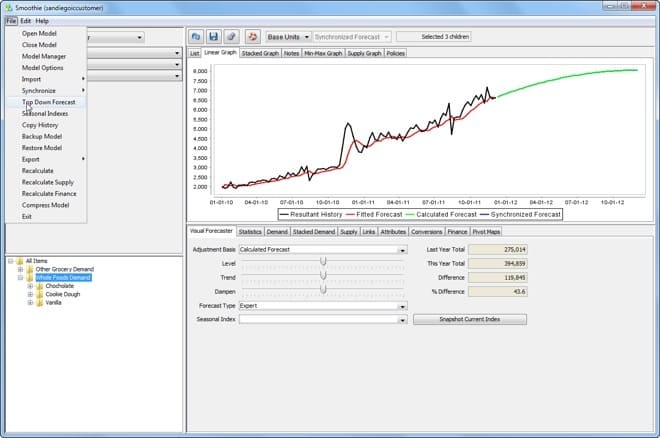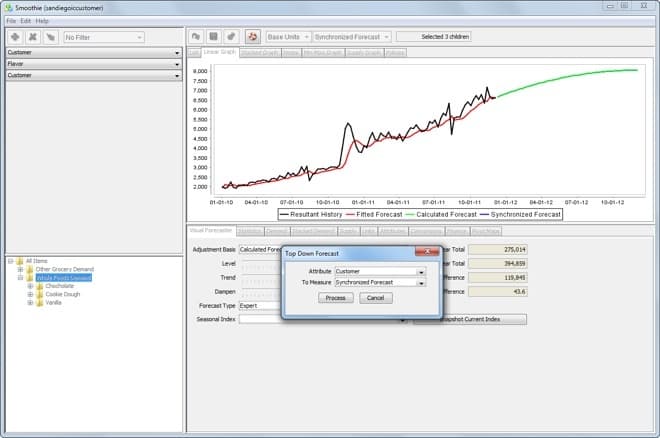How to Best Understand Forecasting at the Customer
Executive Summary
- Forecasting at the customer is a commonly requested item by companies. However, there are problematic issues with doing this.
- Forecasting at the customer is something that leverages a customer forecast hierarchy.
Introduction
As stated, an attribute can be any categorization that one wants to associate with a product. An attribute can also be a customer. There are several ways of associating a customer demand with a product. Coding the product per customer demand would not make a lot of sense, as only one customer per product would be allowed, and nothing would be aggregated. The following three coding methods would work much better:

Above we have assigned two attributes, one for Other Grocery Demand and one for Whole Foods Demand. As this company sells fifty percent of its product to Whole Foods, it makes sense to develop a forecast and an attribute for just this customer demand. Using multiple customer demand attributes would allow for aggregated forecasting by the customer. Not every customer demand would necessarily be entered into the attribute columns—possibly only critical or large customers. The maximum number of attribute columns required would be the maximum number of customers that would be applied to any product. The second method, customer groups, would require less attribute setup but would also provide less flexibility. It would only allow aggregation based upon a grouping of customers and not just one customer. The third method would focus on breaking out only large customers.
See our references for this article and related articles at this link.
Performing the Top-down Forecast
In addition to viewing the forecast by the attribute, top-down forecasting can be performed by any attribute. This is accomplished in Smoothie from the menu I have selected File –> Top-Down Forecast in the screenshot below. Next, select the attribute and then the measure where you want to place the forecast.

This is a straightforward way to perform a top-down forecast. Creating a downward forecast by attributes is highly recommended because the attributes are so flexible, and attributes other than those that are “officially recognized” can be used. “Customer” was used as an example, but any attribute can be used. Being able to alter and add attributes in this flexible manner is a tool that demand planners can adjust and improve their usage of over time.
There are options for different levels of detail when creating a forecast in this way. For instance, an attribute coding system can be designed for the largest customers, while the other customers are non-differentiated. I am differentiating between in their behaviour and forecast accuracy than smaller customers. Having the ability to forecast by attributes allows these types of modelling questions to be asked. And, this modelling flexibility applies to all attributes.
Forecasting by the Customer Demand and Service Level Agreements
One benefit of attribute-based forecasting is that it allows a forecast and forecast aggregations to be created by the customer or customer group. This forecast can later be recombined into a single line item per product location for use in standard supply planning applications. Doing so synchronizes the forecast aggregation type with how the supply plan is managed.
The ability to forecast by customer supports a growing trend in the industry of managing the supply plan by the customer. Many companies are contractually obligated to manage the supply plan by the customer through something called “service level agreements,” or SLAs, which define a specific service level to a customer for a specific level of compensation. SLAs are branching out from where they first developed in service organizations and are becoming popular in finished goods companies.
Attributes for Flexible Hierarchies
Attributes allow for flexible hierarchies or more accurately in Smoothie, attribute sequences to be created for aggregate forecasting, reporting, or simply organization and identification. Attributes are very easily set up in Smoothie and can be set up for any item for which coding of some type can be applied to an SKU. While using this functionality, we have been thinking about how valuable it would be to use either customers or ship tos as attributes.
This would allow both aggregated forecasting and report to be based upon the customer or ship to. This fits neatly into the growing trend that companies have to perform planning in a differentiated way based on either a customer or a defined service level. This is referred to as service level based planning. And this brings up the topic of inventory optimization.
The Relationship to Inventory Optimization
Inventory optimization is a supply planning technology which derives stocking levels based upon service levels. The most advanced inventory optimization software can perform planning in this way by setting the service level not only at the product location but also at the customer contract.
However, upon consideration of the Smoothie flexible attribute abilities on the demand planning side, it is clear that the ability to perform aggregated forecasting by customer or ship-to would be an important complement to supply-side inventory optimization. However, most importantly, a company looking at this solution would need to determine if they are truly committed to managing their supply chain based upon service level agreements rather than traditional product-location approaches.
